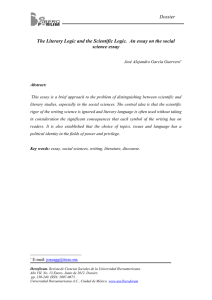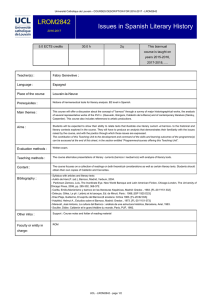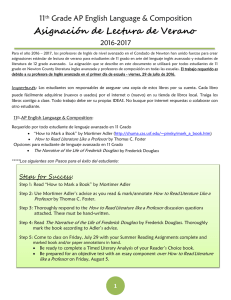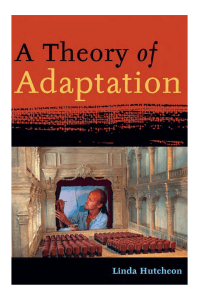jaclr - Universidad Complutense de Madrid
Anuncio
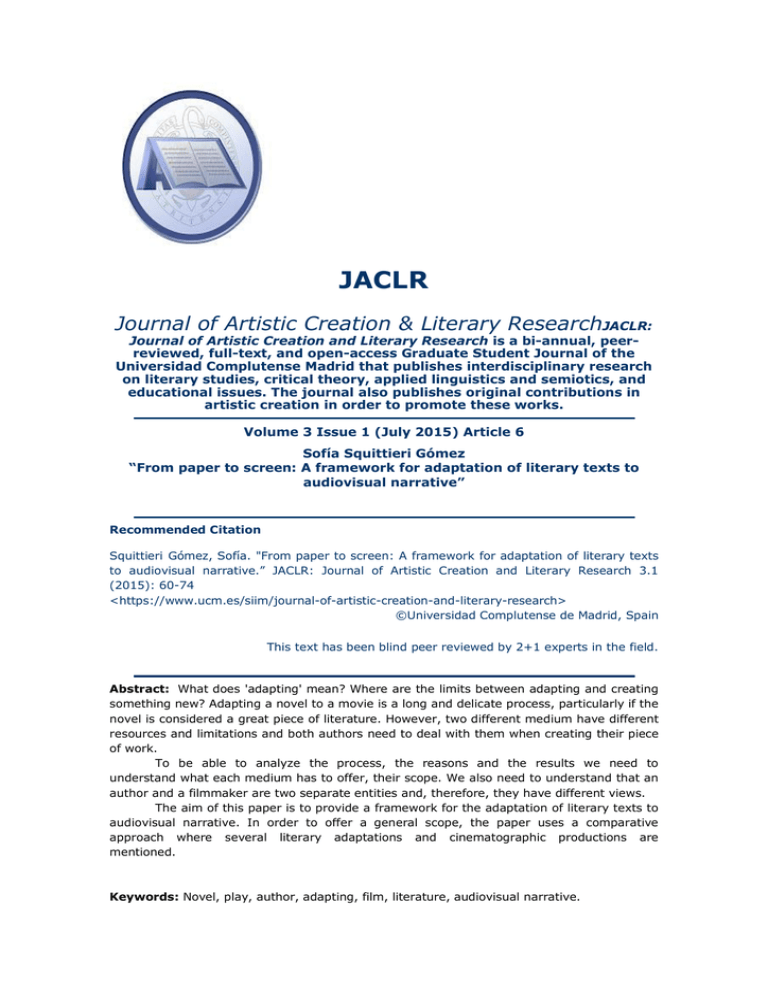
JACLR Journal of Artistic Creation & Literary ResearchJACLR: Journal of Artistic Creation and Literary Research is a bi-annual, peerreviewed, full-text, and open-access Graduate Student Journal of the Universidad Complutense Madrid that publishes interdisciplinary research on literary studies, critical theory, applied linguistics and semiotics, and educational issues. The journal also publishes original contributions in artistic creation in order to promote these works. Volume 3 Issue 1 (July 2015) Article 6 Sofía Squittieri Gómez “From paper to screen: A framework for adaptation of literary texts to audiovisual narrative” Recommended Citation Squittieri Gómez, Sofía. "From paper to screen: A framework for adaptation of literary texts to audiovisual narrative.” JACLR: Journal of Artistic Creation and Literary Research 3.1 (2015): 60-74 <https://www.ucm.es/siim/journal-of-artistic-creation-and-literary-research> ©Universidad Complutense de Madrid, Spain This text has been blind peer reviewed by 2+1 experts in the field. Abstract: What does 'adapting' mean? Where are the limits between adapting and creating something new? Adapting a novel to a movie is a long and delicate process, particularly if the novel is considered a great piece of literature. However, two different medium have different resources and limitations and both authors need to deal with them when creating their piece of work. To be able to analyze the process, the reasons and the results we need to understand what each medium has to offer, their scope. We also need to understand that an author and a filmmaker are two separate entities and, therefore, they have different views. The aim of this paper is to provide a framework for the adaptation of literary texts to audiovisual narrative. In order to offer a general scope, the paper uses a comparative approach where several literary adaptations and cinematographic productions are mentioned. Keywords: Novel, play, author, adapting, film, literature, audiovisual narrative. Squittieri Gómez, Sofía. "From paper to screen: A framework for adaptation of literary texts to audiovisual narrative.” JACLR: Journal of Artistic Creation and Literary Research 3.1 (2015): 60-74 <https://www.ucm.es/siim/journal-of-artistic-creation-and-literary-research> ©Universidad Complutense de Madrid, Spain 61 Sofía SQUITTIERI GÓMEZ From paper to screen: A framework for adaptation of literary texts to audiovisual narrative 1. Background Literature and film are two different and separate media which share a similar purpose: storytelling. While one is limited to paper and words, the other one is able to use in its favor many other resources. This may indicate that they cannot even be compared. Indeed, when adapting from literary text to audiovisual narrative, many problems and limitations arise. However, this also offers an opportunity for creating something new, something that shares its origin, but that it is, at the same time, different. In order to be able to discuss the limits and mechanisms involved in adaptation, first it is necessary to define some aspects that are going to form part of the frame of the analysis. First, the definition of the word 'adaptation' should be considered. According to the Merriam Webster Dictionary, adaptation means: “to change (something) so that it functions better or is better suited for a purpose” and “to change (a movie, book, play, etc.) so it can be presented in another form.” It should perhaps be underlined the fact that both definitions include the keyword “change” in it. Thus, it seems that in an interpretation the responsibility with the original text is less, as the final product is just an accepted vision of a piece. Also of interest are the definitions of 'novel' and ‘drama’. According to the same source, a novel is “an invented prose narrative that is usually long and complex and deals especially with human experience through imaginary characters and a usually connected sequence of events.” Similarly, 'drama' is “a composition in verse or prose intended to portray life or character or to tell a story usually involving conflicts and emotions through action and dialogue and typically designed for theatrical performance”. Finally, the word 'film', which is a recording of moving images that tells a story and that people watch on a screen. Each media format uses different means to tell a story. Novels are limited to paper, and could be accompanied by images (illustrations, photos and so on). Rather than dialogue alone, novels use the narrative mode to express the action and facts, including also some conversations. Everything is put into words –everything– and readers recreate the mental images and emotions in their minds. A big problem in adapting novels to screen are these mental images created in the readers’ minds. The saying “a picture is worth a thousand words” is true, and many readers complain that the movie adaptation do not meet their expectations. The case of drama is a little different. Plays are limited by the use dialogue and the stage location where they are performed. Whatever happens has to happen on a stage. To deal with this limitation, playwrights use the characters' dialogues to narrate, to tell the story, to describe the place beyond the stage and beyond the present of the performance. All what readers/spectators know is told by the characters. Even the characters themselves are described by the way they speak about each other. Both in narrative fiction and in drama, the main communication mode is discourse. On the other hand, movies use primarily images alongside discourse. The use of the iconic and indexical modes in detriment of the symbolic (to use Charles S. Pierce semiotic classification of signs) means that there is less space for imagining or creating mental worlds. Icons (images) are signs that have a relation of similarity with that which they represent. Thus, they do not require much effort in mental decoding. Words, however, are arbitrary symbols that depend on the culture in which they are used, and need to be learnt and interpreted. In movies, much of the mental interpretation of previous discourse (when adapting from narrative fiction for instance) is done by the director. Therefore, we are watching the Squittieri Gómez, Sofía. "From paper to screen: A framework for adaptation of literary texts to audiovisual narrative.” JACLR: Journal of Artistic Creation and Literary Research 3.1 (2015): 60-74 <https://www.ucm.es/siim/journal-of-artistic-creation-and-literary-research> ©Universidad Complutense de Madrid, Spain 62 director's perspective, the image he created in his mind when reading the original text. In movies there are also other resources beside images and words: the point of view of the camera, the use music, the gestures and actions of the characters, and so on. According to how faithful an adaptation is to the original, they can be classified into the following groups (taken from Giannetti 2002: 406): 1. The straight or faithful adaptation, which consists in adapting a narrative fiction into a movie trying to be loyal to the original text, maintaining the original characters, storylines, and if possible, the majority of the events. Nowadays, this strategy is used to attract more people to movie theaters, even though, it is difficult for everyone to be satisfied with the result, for readers and viewers will always be comparing the two products. Examples that would fall in this category would be The book thief and Harry Potter. 2. The interpretative or loose adaptation, preferred by many directors who accept that it is impossible to accurately adapt a book or play to a screen version. Thus, they prefer to focus on the spirit of the story. An example is Apocalypse Now (1979), based on Joseph Conrad's Heart of Darkness. 3. Literal adaptations, which are usually videotaped plays, such as those by Shakespeare or the 1972 version of Emma. The impossible adaptation; those were the source material is so difficult that it becomes impossible to adapt. A challenge in this respect is the adaptation of James Joyce’s novel Ulysses, whose innovative techniques were only partially adapted in Sean Walsh's (2003) version Bloom. 1. Adapting What does adaptation really mean? What are the limits and differences between adaptation, translation, and interpretation? An adaptation tries to be faithful to the original text. But faithful to what? The text itself? the spirit? The length? Is it possible to classify adaptations? What is the right thing to do when adapting a literary piece into a film? Who is the author? Is it still the same story or is it a different one? These are some of the questions I would like to propose for this section whose purpose is to classify and define the relationship between literary fiction and film with regards to adaptation. Ken Dacynger, divides the understanding of adaptation into two basic different groups of viewers: those who expect to see the story they have read just as they have read it and imagined it on the screen, and are usually “angered or disappointed by significant deviation”. And those who are looking for the essence of the novel/play they have read. “not only through story, but also through style.” (Dacynger 2001: 353) However, frequently adapting also means translating. In translation, a text suffers changes because of cultural differences or limitations of the different languages codes, from Spanish to English, for example. These changes need to be made in order to give meaning to the story and maintain the spirit of the original book. Andrew Davis, novelist and screenwriter, explains some of the changes that take place when adapting a text to a movie screen: In novels, we often come to know characters best not through what they say, but through what they are thinking or what is said about them in the narration. A narrator mediates the meaning of what we read through his or her point of view: a coming-of-age story reads much differently if we hear about what happens from the point of view of the person growing up than if we learn about it from that person’s mother, sister, or teacher. But in film, the narrator largely disappears. Sometimes a narrator’s perspective is kept through the use of a voice-over, but generally the director, cast, and crew must rely on the other tools of film to reproduce what was felt, thought, and described on the page. […] scenes need to be modified, more diverse locations written in, and action substituted by long speeches. The sprawling Squittieri Gómez, Sofía. "From paper to screen: A framework for adaptation of literary texts to audiovisual narrative.” JACLR: Journal of Artistic Creation and Literary Research 3.1 (2015): 60-74 <https://www.ucm.es/siim/journal-of-artistic-creation-and-literary-research> ©Universidad Complutense de Madrid, Spain 63 novel might may require characters to be combined, entire subplots lost, and new material written to fit its place. (Interview with Andrew Davis. Web. n.p) The reasons why a filmmaker or screenwriter might make changes when adapting a literary work to a film are varied. They could be simply forced by the medium, as each media have their own tools for expressing and manipulating narrative structure. For example, in a novel, a certain chapter can take the reader to a different setting, a different time period, a memory, a dream or a piece of imagination. In a movie this can be done by using flashbacks, dissolves, crosscuts, or even alternating between color and black and white images. Other options are to organize the material in another way, to get rid of some sections or to rearrange them differently; for example, making the characters talk about an event. Sometimes changes are done in order to highlight a particular theme or introduce a new one, or to transform a particular character into the protagonist or antagonist. Changes are also made to solve problems that the original work has not dealt with, or to strengthen the plot. Bringing a classic story to a contemporary audience may also require change in language and characters traits so that the modern audience can recognize these elements as fitting in their contemporary sensibility and world view. An example of this would be the adaptation of Shakespeare’s works. Some of the problems that may arise when trying to adapt a text to a film can relate to the following: 1) The setting; in fiction, the narrative point of view directs readers to imagine a setting that is physically present. In films, atmosphere, place and setting do not need to be described. 2) Time and Length; the time required to read a novel is very different from the time span captured in a movie or a screenplay. In films, some parts of the story are omitted or told in a different way. In the case of theater, although a play is written to be performed and should not take longer than two or three hours, just like a movie, the language of film and drama are also different. When adapting a play, the filmmaker adds his vision and some scenes can be replaced by others that, although different, may have a similar purpose. American writer and producer who teaches screenplay writing at UCLA, Ron Suppa (2005) has claimed that the mantra of adaptation is “cut, cut, cut”. Because of this, screenwriters are often criticized. Each reader imagines a different thing when reading a literary work (based on their experience in life and their understanding); this means that whoever is adapting a text into a script also has its own vision and his reading is going to be somehow different to everyone else's reading. Each reader is unique. Each reading is unique. Novelist John LeCarré famously claimed that having one of his novels adapted to screen is “like having a cow turned into a bouillon cube.” In Novels into Film, George Bluestone has claimed that “between the percept of the visual image and the concept of the mental image lies the root difference between the two media” (1957: 1) Thus, the filmmaker has two options: either he/she tries to stick to the original text and portray it as he/she has understood it –conscious of possible audience deception– or to create a great movie (the goal is to create a good movie not a good adaptation) that can be enjoyed by everyone even if they have not read the book. In this option, he/she decides the element/s to be kept according to his/her unique vision and/or directed to a certain type of audience. DeWitt Bodeen, co-author of the screenplay of Peter Ustinov’s Billy Budd (1962), claims that: “Adapting literary works to film is, without a doubt, a creative undertaking, but the task requires a kind of selective interpretation, along with the ability to recreate and sustain an established mood”. (1963: 349) Therefore, to be able to enjoy an adaptation the audience needs to be aware that a movie may be a separate and different production from the original novel in which was based. The director's vision needs to be added to that of the writer, so there will be two visions, two stories. The medium is also important. The term ‘movie’ comes from ‘moving pictures’ because initially films were made by putting together a number of images in an animated Squittieri Gómez, Sofía. "From paper to screen: A framework for adaptation of literary texts to audiovisual narrative.” JACLR: Journal of Artistic Creation and Literary Research 3.1 (2015): 60-74 <https://www.ucm.es/siim/journal-of-artistic-creation-and-literary-research> ©Universidad Complutense de Madrid, Spain 64 sequence. A painting or a photograph are static images, composed to be enjoyed in a shorter time span and in fixed contemplation. As Aristotle wrote: Epic poetry and Tragedy, Comedy and Dithyrambics poetry, and the music of the flute and the lyre in most of their forms are all in their general conception modes of imitation. They differ, however, form one another in three respects—the medium, the objects, the manner or mode of imitation, being in each case distinct. For as there are persons who, by conscious art or mere habit, imitate and represent various objects through the medium of color and form, or again by the voice; so in the arts above mentioned, taken as a whole, the imitation us produced by rhythm, language or 'harmony,' either singly or combined. (Poetics, MIT web n.p.) When adapting a poem to a movie screen, as in the case of Splendor in the grass (1961) adaptation of William Wordsworth's Ode intimations of immortality from recollections of early childhood, many changes are necessary. When adapting novels and theater we have other limitations. Theater needs more words in order to describe the setting and balance out the fact that everything happens on a limited stage. In film, the script is shorter, we have images and music that help tell the story so there is no need for so many words. The medium also conditions the manner in which the story is told. In a movie, decisions such as the setting and angle of the camera, the perspective and the duration of each take, all contribute to create an atmosphere and contribute to the storytelling. Indeed, the film director can do with the script whatever he/she wants, in contrast to theater where the director needs to respect the text much more. To conclude this section, the criterion to decide whether a film is a good adaptation or not does not rely on its true relationship to the original text. It is more a matter of whether or not the final product is a good movie. Indeed, many excellent movies, some of which have received awards, are free adaptations based on literary works. To give some examples, The Color Purple (1985), The Dead (1987), Moby Dick (1956), A Streetcar Named Desire (1951), West Side Story (1961), or Hamlet (1948). 2. Classification I propose six categories for adaptations based on the following parameters: 2.1. Audience Films can be adapted and modified in order to address a different audience than the original text. The reasons vary: to make children enjoy the greatest novels; to simplify the story to broaden the audience; or to make it appealing to teenagers, for instance. An example would be the adaptation from Shakespeare's Hamlet to Disney's production of The Lion King (1994). In this adaptation, Walt Disney Pictures decided to maintain the characters transferring them to the animal world. The plot is also slightly changed in order simplify it for children. Subplots are also a little modified. Plot Hamlet tells the story of a Danish prince whose uncle (Claudius) betrays his brother (Hamlet's father) and kills him to become king. Hamlet grows up with his uncle until one night his father's ghost makes an appearance and reveals him who was his murderer and asks his son to take revenge. After a long time of reflection and of dealing with his conscience, he kills his uncle Claudius. Most of the characters die. In The Lion King, Simba is Hamlet, Scar is Claudius and Hamlet's father is Mufasa. In The Lion King the dialogue is simpler than in Hamlet, and the violent scenes and deaths are removed. The themes of the story are still greed, avarice, ambition, the search for power, family treachery and revenge. Subplots: The main two differences between the original Hamlet and this adaptation are in the subplots. Hamlet's friends who are supposed to be Rosencrantz and Guildenstern, are actually spying him under Claudius orders. Simba does have two friends: Timon and Pumbaa. Hamlet rejects Ophelia provoking her suicide. Ophelia is deeply in love with him Squittieri Gómez, Sofía. "From paper to screen: A framework for adaptation of literary texts to audiovisual narrative.” JACLR: Journal of Artistic Creation and Literary Research 3.1 (2015): 60-74 <https://www.ucm.es/siim/journal-of-artistic-creation-and-literary-research> ©Universidad Complutense de Madrid, Spain 65 and cannot stand his rejection. On the other side, Simba falls in love with Nala and they are together happily ever after. Characters Hamlet The Lion King Claudius Scar Old King Hamlet Mufasa Hamlet Simba Ophelia Nala Horacio Rafiki Polonius Zazu Laertes Hyenas Rosencrantz & Guildenstern Timon and Pumbaa Language: The language is clearly modified. The words change but the meaning remains. Scar: Run, Simba. Run away and never return Act IV, Scene III Claudius: Hamlet, this deed, for thine especial safety— Which we do tender as we dearly grieve For that which thou hast done—must send thee hence With fiery quickness. Therefore prepare thyself. The bark is ready and the wind at help, Th' associates tend, and everything is bent For England. Simba: Yeah, but I pulled it off Act II, Scene II Hamlet: The play’s the thing Wherein I’ll catch the conscience of the king. Scar: Kill him Act IV, Scene III Claudius: Pays homage to us—thou mayst not coldly set Our sovereign process, which imports at full, By letters congruing to that effect, The present death of Hamlet. Do it, England, For like the hectic in my blood he rages, And thou must cure me. Till I know ’tis done, Howe'er my haps, my joys were ne'er begun. Many of the verses of the original play were substituted by action or songs that are the character's inner monologues. This way children can enjoy the great literature of Shakespeare from their first years and older people can watch it with them. The only problem is that it is usually later in life, once your read Hamlet, you realize there are coincidences that might or not be that, a coincidence. Lewis Carroll’s Alice's Adventures in Wonderland is another famous example of adaptation which has undergone several modifications in order to fit the screen. Squittieri Gómez, Sofía. "From paper to screen: A framework for adaptation of literary texts to audiovisual narrative.” JACLR: Journal of Artistic Creation and Literary Research 3.1 (2015): 60-74 <https://www.ucm.es/siim/journal-of-artistic-creation-and-literary-research> ©Universidad Complutense de Madrid, Spain 66 2.2. Musical Adaptation to musical versions is an important parameter to take into consideration. In order to create a musical from a play without music, monologues have been transformed into songs. This way, the thoughts, feelings and worries of the characters are expressed through songs, adding another way of expression that undoubtedly works to transmit the meaning of the soliloquies. An example is the musical West Side Story (1961) based on an adaptation of Shakespeare’s Romeo and Juliet. To offer a concrete example, I shall concentrate on Act II, Scene II where Romeo and Juliet confess their love at night and decide to run away together and get married. This scene was transformed into the song “Tonight” in West Side Story. MARIA: Only you, you're the only thing I'll see forever / In my eyes in my words and in everything I do / Nothing else but you / Ever TONY: And there's nothing for me but Maria / Every sight that I see is Maria TONY: Always you, every thought I'll ever know / Everywhere I go you'll be TONY & MARIA: All the world is only you and me MARIA: Tonight, tonight / It all began tonight / I saw you and the world went away / Tonight, tonight / There's only you tonight / What you are, what you do, what you say TONY: Today, all day I had the feeling / A miracle would happen / I know now I was right TONY & MARIA: For here you are / And what was just a world is a star /Tonight / Tonight, tonight / The world is full of light / With suns and moons all over the place (...) Today, the world was just an address / A place for me to live in / No better than all right / But here you are / And what was just a world is a star / Good night, good night / Sleep well and when you dream / Dream of me /Tonight Squittieri Gómez, Sofía. "From paper to screen: A framework for adaptation of literary texts to audiovisual narrative.” JACLR: Journal of Artistic Creation and Literary Research 3.1 (2015): 60-74 <https://www.ucm.es/siim/journal-of-artistic-creation-and-literary-research> ©Universidad Complutense de Madrid, Spain 67 The table of characters equivalences is below: Romeo and Juliet West Side Story Nurse Anita Paris Chino Romeo Tony Baby John Montagues Jets Juliet Maria Capulets Sharks Tybalt Bernardo Friar Lawrence Doc Prince Escalus Krupke Mercutio Riff Abraham A-Rab Sampson Action Benvolio Romeo and Juliet West Side Story Verona NYC – Upper West Side Capulet House Gym Doc's shop Apothecary & Laurence's Cell Juliet's Balcony Maria's Fire Scape Capulet's home The Dress Shop Open Streets of Verona Under the Highway Rumble Capulet's Tomb Playground Year 1594 approximately 1957 Story Opposing families Opposing gangs Both die Only he dies He kills himself when he discovers she is dead He gets killed She kills herself when she discovers he is dead She doesn't kill herself but threatens the gangs Swords Guns Spoken soliloquy expressing feelings Soliloquies in the form of songs to express feelings Marriage taken seriously Marriage brought up as a joke Setting West Side Story is set on the West Side of New York City and follows the story of Romeo and Juliet but in a different context. The story begins with a fight between two groups of people (although the reasons are different in play and film). Tony (Romeo) and Squittieri Gómez, Sofía. "From paper to screen: A framework for adaptation of literary texts to audiovisual narrative.” JACLR: Journal of Artistic Creation and Literary Research 3.1 (2015): 60-74 <https://www.ucm.es/siim/journal-of-artistic-creation-and-literary-research> ©Universidad Complutense de Madrid, Spain 68 Maria (Juliet) fall in love. They know they cannot be together because they belong to different worlds. In the case of Romeo and Juliet, one belongs to a rich family and the other to a poor one; in the case of Tony and Maria, they belong to rival street gangs. Nevertheless, they decide to be together in secret. As in the play, Bernardo (Tybalt) kills Riff (Mercutio) in a fight and Tony (Romeo) kills Bernardo (Tybalt). After this episode, Tony (Romeo) has to escape and Maria (Juliet) has an idea to go with him. However there is a misunderstanding. Tony (Romeo) thinks Maria (Juliet) is dead and wants to die. Romeo kills himself. Tony is shot by Chino. Juliet kills herself when she discovers Romeo is dead. Maria wants to commit suicide when Tony dies in her arms but she finally does not. 3. Changes of time Oscar Wilde’s drama Lady Windermere's Fan was adapted to the screen as A Good Woman (2004). Although the plot is mostly preserved, there are some changes. Oscar Wilde's play takes place in London; the movie is set on the Almafi coast (Italy) in the 1930s instead of the 1890s. Although the setting is impressive and the story itself works, there is a huge problem. Oscar Wilde satirizes Victorian society. His words are sharp, witty and intelligent; his dialogues ironic, full of symbolism and metaphors. Wilde’s style of writing is just as important and rich as the content and context of his plays. The change of setting, therefore, does not quite work, because many of the events in Wilde's story occur in the telling and the dialogues which only make real sense in the context. The chief interest of the movie lies on a few preserved dialogues, while many others have lost their original wit: Play Film Crying is the refuge of plain women and the ruin of Crying is the refuge of plain women. Pretty women pretty ones. go shopping. The question that may arise is, what would we think about the movie itself if we didn't know it had been adapted from a play or if we had not read Wilde's play? The movie and the play are two different things and the play might just have been an inspiration for the director of the movie. The purpose of changing the setting and/or time period is mostly to make it more appealing to the audience. However, the choice of time and space has to be powerful, at least as powerful as the original and make sure everything else keeps making sense. If it doesn't, you can always change the story to make it better, as the idea of adapting is being able to change and modify whatever you're adapting to make it work in another media. 2.3. Political and Social Adaptations To move from Heart of Darkness to Apocalypse Now (1979) is to travel from Africa to Vietnam. Joseph Conrad's Heart of Darkness takes place in colonial Africa and tells the story of Marlow who travels up the Congo River to meet an obscure character named Kurtz. John Milius’s original screenplay moved Joseph Conrad’s 1898 novel Heart of Darkness from colonial Africa to the heart of the Vietnam War in the late 1960s. Directed by Francis Ford Coppola, and adapted to the screen by John Milius, they maintained the structure of the story how it was. Although it seems hard to say one is adapted from the other, once you read the book and you see the movie it becomes clear. It is impressive how the main characteristic of the book, the use of “stream of consciousness” is translated to the film and fitted to a new context. To make sure this was this way, Coppola made actors improvise and cut and added scenes to Milius script. The movie keeps the main plot: “a man travels upriver to face an evil genius and, along the way, must face his fears, his mortality, and the possibility that he will go slowly insane.” Although they are adapted to the new theme, the characters remain the same. For example, Coppola's Army is also a hypocrite and Squittieri Gómez, Sofía. "From paper to screen: A framework for adaptation of literary texts to audiovisual narrative.” JACLR: Journal of Artistic Creation and Literary Research 3.1 (2015): 60-74 <https://www.ucm.es/siim/journal-of-artistic-creation-and-literary-research> ©Universidad Complutense de Madrid, Spain 69 disorganized band of men who is questioned by the central characters, just like Conrad's Company. Both protagonists, Willard and Marlow become more aware of the “moral darkness” that surround them. The river has also a role which drives the character apparently insane. What Coppola was aiming with his film was to create "an experience that would give my audience a sense of the horror, the madness, the sensuousness and the moral dilemma of the Vietnam war." (Payan 1992) 2.4. Maintaining the original text Michael Radford’s adaptation (2004) of Shakespeare’s The Merchant of Venice is faithful to the play. Most of the dialogues are maintained or very slightly modified to fit the screen. However, there are only a few differences between the original and the script, which are related to character choices, particularly with regards to the representation of Shylock. Shakespeare's Jewish character is presented as a villain and a victim, while in Radford's adaptation he is just presented as a victim. In fact, the movie starts explaining how Jews were persecuted in Venice and choices are made to represent the Jewish community as being mistreated. There is an image were we can see Antonio spitting on Shylock. Also, at the end of the movie, Shylock's daughter, Jessica, feels petty for him that has had to convert to Christianity. All the passages in which Shakespeare presented him as a villain have been removed. For instance, the following one: “How like a fawning publican he looks! I hate him for he is a Christian, But more for that in low simplicity He lends out money gratis and brings down The rate of usance here with us in Venice. If I can catch him once upon the hip, I will feed fat the ancient grudge I bear him. He hates our sacred nation, and he rails, Even there where merchants most do congregate, On me, my bargains and my well-won thrift, Which he calls “interest.” Cursed be my tribe If I forgive him!” (Act I Scene III) There is also a scene where he says he prefers his daughter dead than seeing her with a Christian. Some fragments are preserved as in the original play, for instance, Shylock's soliloquy: “He hath disgraced me and hindered me half a million, laughed at my losses, mocked at my gains, scorned my nation, thwarted my bargains, cooled my friends, heated mine enemies—and what’s his reason? I am a Jew. Hath not a Jew eyes? Hath not a Jew hands, organs, dimensions, senses, affections, passions? Fed with the same food, hurt with the same weapons, subject to the same diseases, healed by the same means, warmed and cooled by the same winter and summer as a Christian is? If you prick us, do we not bleed? If you tickle us, do we not laugh? If you poison us, do we not die? And if you wrong us, shall we not revenge? If we are like you in the rest, we will resemble you in that. If a Jew wrong a Christian, what is his humility? Revenge. If a Christian wrong a Jew, what should his sufferance be by Christian example? Why, revenge. The villainy you teach me I will execute—and it shall go hard but I will better the instruction.” ( Act III Scene I) 1 1 The clip of the movie can be seen at: <https://youtu.be/T_5adzpdkdw> Squittieri Gómez, Sofía. "From paper to screen: A framework for adaptation of literary texts to audiovisual narrative.” JACLR: Journal of Artistic Creation and Literary Research 3.1 (2015): 60-74 <https://www.ucm.es/siim/journal-of-artistic-creation-and-literary-research> ©Universidad Complutense de Madrid, Spain 70 During the trial scene, everything is just as Shakespeare wrote it. Not a comma has been changed or removed. PORTIA: Is your name Shylock? SHYLOCK: Shylock is my name. PORTIA: Of a strange nature is the suit you follow, Yet in such rule that the Venetian law Cannot impugn you as you do proceed.— (to ANTONIO) You stand within his danger, do you not? ANTONIO: Ay, so he says. PORTIA: Do you confess the bond? ANTONIO: I do. PORTIA: Then must the Jew be merciful. SHYLOCK: On what compulsion must I? Tell me that. PORTIA: The quality of mercy is not strained. It droppeth as the gentle rain from heaven Upon the place beneath. It is twice blessed: It blesseth him that gives and him that takes. 'Tis mightiest in the mightiest. It becomes The thronèd monarch better than his crown. His scepter shows the force of temporal power, The attribute to awe and majesty Wherein doth sit the dread and fear of kings, But mercy is above this sceptered sway. It is enthronèd in the hearts of kings. It is an attribute to God himself. And earthly power doth then show likest God’s When mercy seasons justice. Therefore, Jew, Though justice be thy plea, consider this— That in the course of justice none of us Should see salvation. We do pray for mercy, And that same prayer doth teach us all to render The deeds of mercy. I have spoke thus much To mitigate the justice of thy plea, Which if thou follow, this strict court of Venice Must needs give sentence 'gainst the merchant there. (Act IV Scene I) 2 2 Clip of the film at <https://youtu.be/C8qs_Nv4fgw> Squittieri Gómez, Sofía. "From paper to screen: A framework for adaptation of literary texts to audiovisual narrative.” JACLR: Journal of Artistic Creation and Literary Research 3.1 (2015): 60-74 <https://www.ucm.es/siim/journal-of-artistic-creation-and-literary-research> ©Universidad Complutense de Madrid, Spain 71 2.5. Hollywoodized Best sellers This term was coined by Rachel Malchow, a graduate student at the University of Minnesota. In this section we can include many titles, as the Entertainment industry in Hollywood is always for the search of good stories to turn into the next hit. Sometimes they adapt best sellers, sometimes classics. But whatever the original piece is, the final product is always clearly directed to collect money. The taming of the Shrew (William Shakespeare) 10 things I hate about Story of a boy that is paid to woo Julia Stiles, the you "shrew," so that her father will allow her younger (Gil Junger, 1999) sister to date. Conserves some of the names of the original piece: Kat for (Katherina) and her younger sister Bianca. It even sneaks in a Shakespearean quote: "I burn, I pine, I perish" It also adds typical elements of this type of movies: high-school dance, awkward poetry and dates. The Color Purple (Alice Walker) The Color Purple (Steven Spielberg, 1958) In this case the movie tries to be faithful to the original and, directed by Spielberg, it is actually a good movie. Harry Potter (J. K. Rowling) Harry Potter (Christopher Colombus, Alfonso Cuarón, Mike Newell, David Yates) Harry Potter is a clear example of the fact that each director has a vision about a book as each time the director changed the film's tone and even settings changed too. Hogwarts, is different in the first and in the third movie, but the castle described by J. K. Rowling is always the same. Othello (William Shakespeare) O (Tim Blake Nelson, 2001) Although it is a knock-off of Othello's Desdemona (Desi in the film). Tells the story of Odin James, a young basketball player with a great future who can clearly dedicate his life to play basket. He is popular in school and dates the deans beautiful daughter, Desi Brable. Hugo Goulding the dean's son becomes really jealous. Hamlet The Lion King Romeo and Juliet West Side Story Lady Windermere's Fan A Good Woman x Heart of Darkness Apocalypse Now x The Merchant of Venice The Merchant of Venice The taming of the Shrew 10 Things I Hate About You The Color Purple The Color Purple Hollywoodized Film Original Text Original text x War / Politics / Social Time Musical Audience Although each movie usually has its reasons to be adapted, some of these divisions can be combined: x x x x x x x x x x x x x Squittieri Gómez, Sofía. "From paper to screen: A framework for adaptation of literary texts to audiovisual narrative.” JACLR: Journal of Artistic Creation and Literary Research 3.1 (2015): 60-74 <https://www.ucm.es/siim/journal-of-artistic-creation-and-literary-research> ©Universidad Complutense de Madrid, Spain 72 Harry Potter Harry Potter Othello O x x x 3. Conclusion Adapting, changing the language, the code of a literary piece of work to a film is as a task that requires interpretation of the original piece of work. When reading a novel and discussing it with other people, it is common to differ in some aspects of the analysis and of the understanding of character decisions. The images we create in our minds as readers are also different. Actually, when reading the a novel in two different moments in our lives we understand it differently. Hence, it is practically impossible that the audience coincides with the filmmakers’ vision. When looking at a movie adaptation, one must bear in mind that although there is a connection between the two pieces, they are not the same story. Some of the adaptations can help the audience imagine what authors wrote many years ago. If they have tried to be faithful to the original or kept the essence, they can help understand the setting, the characters and the story. It is also interesting to see how others have perceived a novel or a play. And it is even more interesting when more than one adaptation has been made. Adapting means transforming, creating, changing, and like every artistic product, adaptations are subject to criticism, opinions and tastes. This paper has offered a framework of some of the problems encountered when adapting narrative fiction or theater to screen. Despite the problems, in the end, literary texts and audiovisual narrations share a purpose, which is storytelling. Thus, the story should always prevail. Works Cited Aristotle. Poetics. MIT Classic Archive. Trans. S. H. Butcher. Web. <http://classics.mit.edu/Aristotle/poetics.1.1.html> Bluestone, George. Novels into Film. Baltimore: University of California Press: Berkeley (UC Berkeley) and Los Angeles (UCLA), 1957. Print. Bodeen, DeWitt. "The Adapting Art." Films in Review, 14/6 (June-July 1963), 349. Print. Conrad, Joseph. Heart of Darkness. New York: Columbia UP, 1999. Print. Dancyger, Ken, and Jeff Rush. "Successful Adaptations." Alternative Scriptwriting. 4th ed. Boston: Focal, 2012. Print. ----. Alternative Scriptwriting. Successfully Breaking the Rules. 3rd ed. Focal, 2001. Print. Davies, Andrew. "Longing, Betrayal & Redemption. An Interview with Screenwriter Andrew Davies." Masterpiece. PBS. Web. 27 May 2015. <http://www.pbs.org/wgbh/masterpiece/austen/davies.html> Halliwell, Stephen. Aristotle's Poetics. Chapel Hill: U of North Carolina, 1986. Print. Hernández Les, Juan A., and Francisco Delgado. Cine y literatura. Una metáfora visual. Madrid: Ediciones JC. Print. Giannetti, Louis D. Understanding Movies. 11th ed. Prentice Hall, 2007. Print. Lozano, Susana. . “La adaptación cinematográfica y el lenguaje del cine frente a la literatura” Merriam-Webster English Dictionary. Merriam-Webster. Web. 23 February 2015. <http://www.merriam-webster.com/> Payan, Miguel Juan. Francis Ford Coppola. Madrid: Ediciones JC, 1992. Print. Shakespeare, William. The Taming of the Shrew. Ed. Thomas Goddard Bergin. New Haven: Yale UP, 1954. Print. ----. The Tragedy of Romeo and Juliet. New ed. New York: Washington Square, 1959. Print. x x Squittieri Gómez, Sofía. "From paper to screen: A framework for adaptation of literary texts to audiovisual narrative.” JACLR: Journal of Artistic Creation and Literary Research 3.1 (2015): 60-74 <https://www.ucm.es/siim/journal-of-artistic-creation-and-literary-research> ©Universidad Complutense de Madrid, Spain 73 ----. Four Great Tragedies: Hamlet, Othello, King Lear, Macbeth. New York: Signet, 1998. Print. ----. The Merchant of Venice. New Haven: Yale UP, 2006. Print. Suppa, Ron. Real Screenwriting Strategies and Stories from the Trenches. Boston, MA: Thomson Course Technology PTR, 2005. Print. Wilde, Oscar, and Ian Small. Lady Windermere's Fan: A Play about a Good Woman. London: Ernest Benn, 1980. Print. Works Cited: film productions: 10 Things I He about You. Dir. Gil Junger. Perf. Julia Stiles, Heath Ledger, Joseph GordonLevitt. Touchstone Pictures, 1999. DVD. A Good Woman. Dir. Mike Barker. Perf. Helen Hunt, Scarlett Johansson, Milena Vukotic, Stephen Campbell Moore. 2004. DVD. Alice's Adventures in Wonderland. Dir. William Sterling. Animation. Joseph Shaftel Productions, 1972. DVD. Apocalypse Now. Dir. Francis Ford Coppola. Perf. Martin Sheen, Marlon Brando, Robert Duvall, Frederic Forrest, Laurence Fishburne, Sam Bottoms, Albert Hall, Dennis Hopper. United Aetists, 1979. DVD. A Streetcar Named Desire. Dir. Elia Kazan. Perf. Vivien Leigh, Marlon Brando, Kim Hunter, Karl Malden, Rudy Bond, Nick Dennis, Peg Hillias, Richard Garrick, Ann Dere. Warner Bros Pictures, 1951. DVD. Billy Budd. Dir. Peter Ustilnov. Perf. Peter Ustinov, Robert Ryan, Terence Stamp, Melvyn Douglas, David MacCallum, John Neville. Allied Artists / Rank Film Distributors, 1962. DVD. Bloom. Dir. Sean Walsh. Perf. Stephen Rea, Angeline Ball, Hugh O'Conor. Odyssey Pictures, 2003. DVD. Emma. Dir. John Glenister. Perf. Doran Godwin, John Carson, Donald Eccles. BBC, 1972. Hamlet. Dir. Laurence Olivier. Perf. Laurence Olivier, Jean Simmons, Basil Sydney, Eileen Herlie, Felix Aylmer, Terence Morgan. Rank Organisation, 1948. DVD. Harry Potter and the Chamber of Secrets (Harry Potter 2). Dir. Chris Colombus. Perf. Daniel Radcliffe, Rupert Grint, Emma Watson. Warner Bros Pictures / Heyday Films /1492 Pictures, 2002. DVD. Harry Potter and the Deathly Hallows: Part I. Dir. David Yates. Perf. Daniel Radcliffe, Emma Watson, Rupert Grint. Warner Bros Pictures / Heyday Films. 2010. DVD. Harry Potter and the Deathly Hallows: Part II. Dir. David Yates. Perf. Daniel Radcliffe, Emma Watson, Rupert Grint. Warner Bros Pictures / Heyday Films. 2011. DVD. Harry Potter and the Goblet of Fire (Harry Potter 4). Dir. Mike Newell. Perf. Daniel Radcliffe, Emma Watson, Rupert Grint. Warner Bros Pictures, 2005. DVD. Harry Potter and the Half-Blood Prince (Harry Potter 6). Dir. David Yates. Perf. Daniel Radcliffe, Emma Watson, Rupert Grint. Warner Bros Pictures / Heyday Films, 2009. DVD. Harry Potter and the Order of the Phoenix (Harry Potter 5). Dir. David Yates. Perf. Daniel Radcliffe, Emma Watson, Rupert Grint. Warner Bros Pictures, 2007. DVD. Harry Potter and the Prisoner of Azkaban (Harry Potter 3). Dir. Alfonso Cuarón. Perf. Daniel Radcliffe, Emma Watson, Rupert Grint. Warner Bros Pictures / Heyday Films / 1492 Films, 2004. DVD. Harry Potter and the Sorcerer's Stone. Dir. Chris Colombus Yates. Perf. Daniel Radcliffe, Rupert Grint, Emma Watson. Warner Bros Pictures / Heyday Films / 1492 Films / Duncan Henderson, 2001. DVD. Moby Dick. Dir. John Huston. Perf. Gregory Peck, Orson Welles, Richard Basehart, Leo Genn. Metro-Goldwyn-Mayer, 1956. DVD. O. Dir. Tim Blake Nelson. Perf. Julia Stiles, Josh Hartnett, Martin Sheen, Mekhi Phifer. Lions Squittieri Gómez, Sofía. "From paper to screen: A framework for adaptation of literary texts to audiovisual narrative.” JACLR: Journal of Artistic Creation and Literary Research 3.1 (2015): 60-74 <https://www.ucm.es/siim/journal-of-artistic-creation-and-literary-research> ©Universidad Complutense de Madrid, Spain 74 Gate Films, 2001. DVD. Splendor in the Grass. Dir. Elia Kazan. Pef. Natalie Wood, Warren Beatty, Pat Hingle, Audrey Christie. Warner Bros, 1961. DVD. The Book Thief. Dir. Brian Pecival. Perf. Sophie Nélisse, Geoffrey Rush, Emily Watson, Nico Liersch, Ben Schnetzer. Fox 2000 Pictures / Studio Babelsberg, 2013. DVD. The Color Purple. Dir. Steven Spielberg. Perf. Danny Glover, Whoopi Goldberg, Adolph Caesar, Akosua Busia, Laurence Fishburne, Oprah Winfrey, Rae Dawn Chong, Margaret Avery, Bennet Guillory. Warner Bros. / Amblin Entertainment, 1985. DVD. The Dead. Dir. John Huston. Perf. Anjelica Huston, Donald McCann, Helena Carroll, Cathleen Delany, Ingrid Craigie. Channel 4 / Delta Film / Liffey Films / Vestron Pictures / Zenith Entertainment, 1987. DVD. The Lion King. Dir. Rob Minkoff, Roger Allers. Perf. Animation. Walt Disney Pictures, 1994. DVD. The Merchant of Venice. Dir. Michael Radford. Perf. Al Pacino, Jeremy Irons, Joseph Fiennes, Lynn Collins, Zuleikha Robinson, Kris Marshall, Charlie Cox, Mackenzie Crook, John Sessions, Heather Goldenhersh. Sony Pictures, 2004. DVD. West Side Story. Dir. Robert Wise, Jerome Robbins. Perf. Natalie Wood, Richard Beymer, George Chakiris, Russ Tamblyn, Rita Moreno, Simon Oakland, Ned Glass, William Bramley, Tucker Smith, Tony Mordente. Metro-Goldwyn-Mayer, 1961. DVD. Bioprofile of the author: Sofía Squittieri has a bachelor degree in "English Studies" by the Universidad Complutense de Madrid and majored in "Dramatic Arts" by the Escuela de Interpretación Cristina Rota. She was granted a scholarship at the University of California Los Angeles (UCLA) where she took courses on English, Linguistics, Film and Theater. Currently she is an actress, translates subtitles and writes opinion articles for an online magazine set in the US. Contact: <[email protected] >

